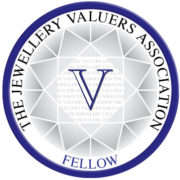
I tried to insure my jewellery but the insurance company says I have to have a valuation.
Your insurer needs to know what the risk is so they can calculate your premium. They will accept the valuation of a Fellow of the Jewellery Valuers Association.
I don't want to insure my jewellery I just want to know what it's worth.
A valuation has to be written for a specific purpose. “What its worth” can mean different things depending on circumstances. Unless you have another reason in mind what you probably want is an insurance valuation which will give the current retail replacement value. If you are thinking of selling jewellery then obtaining an offer from a retailer or getting an auctioneers estimate is usually free. We will perform “Open Market” valuations for those who prefer to have expert guidance on the worth of jewellery without going down this route.
I like the idea of saving money. How does a valuation do that?
When you take out insurance for jewellery items it is not always made clear that it will be up to you to prove your claim in the event of a loss. Unless you have a complete set of receipts going back possibly many years this is going to be difficult. How would you prove the worth of Granny’s diamond ring for example? If you take a chance but insure for more than is necessary you will pay too much premium, possibly over a very long period. On the other hand, under insure and you will not get full compensation – you will have paid your premiums for nothing.
I want to sell my jewellery and I want a certificate which proves its worth what I'm asking.
A valuation has to be addressed to a person or persons. We cannot undertake “to whom it may concern” valuations. A valuation for open market sale is typically addressed to the seller only and is in the form of confidential advice. It cannot be used as “proof” of value to a third, unknown party.
When should I get my jewellery re-valued?
We recommend that valuations are checked every three years or so. It is quite possible there has not been much change in so short a time but variations in exchange rates and prices of raw materials can have a dramatic effect. We have all the details we need on file so a re-examination of the item is all that is required. We charge a reduced fee for a nice clean, crisp document and a small, fixed charge per item.
The antiques road-show do valuations free so why does it cost what it does?
A valuation must be in writing to mean anything. We research, we measure, we weigh, we calculate, we use instruments all to arrive at a sensible value. We then write it down and sign it! All this needs considerable investment in terms of experience, equipment and training so we have to charge a professional fee. View an animated sample jewellery valuation.
What if I disagree with your valuation or spot what I think is an error?
We pride ourselves on accuracy and disagreements arise only very rarely. Your first course should always be to ask the valuer for an explanation. There is frequently a simple reason for what may look like a mistake. We would always aim for maximum customer satisfaction so don’t be afraid to get in touch.
I don't want to risk sending my jewellery in the post.
Book an in-person appointment to visit the office. If you do not wish to do this there are other options. For large collections ask about a home visit, or if this is not possible we can collect jewellery and deliver it when the work is complete. We have to make a charge for this service which would be based on the length/time of the overall journey (ask for details). You can post jewellery to us and many of our trade customers all over the British Isles do just that on a daily basis. Indeed the jewellery trade could not operate at all without Special Delivery post. We operate a speedy postal service for jewellers and the public alike.
I have a laboratory report or receipt which states my gemstone weighs more (or less) than you said in the valuation.
We always check the parameters of each stone against any laboratory report or receipt if available. We use accurate tables and formulae to work out the approximate weight based on the stone’s measurements and will point out a difference in weight calculation, if there is one. It is usually not advisable to un-set a gemstone to confirm its weight since this can be costly and may result in damage to the stone and the mount. If there is a laboratory report to hand and there is very little or no difference, the stated weight is taken to be correct, if it was obtained by actual weighing. Similarly, measurements in a report from an internationally reputable laboratory are usually obtained using very accurate optical measuring devices and are generally accepted as correct. A large discrepancy would indicate that the stone did not match the report and this would be pointed out. It is a very good idea to give the valuer a copy of any laboratory report before the appraisal takes place.
The Consignment Form asks me to provide sales data, receipts, certificates, old valuations and the like, why do you need all this information? I thought you valuers were experts!
This information is useful to the valuer when he has to appraise recent purchases. In order to arrive at a valuation for insurance we need to establish the market in which replacement will be made so we need to know where the item was purchased and when. This is known as showing “due diligence”. Receipts often have details of stone weights and other provenance which can be helpful. The trading position and quality of service offered by the retail establishment you bought from can make a big difference to the asking price. If information which could effect the valuation is withheld the valuation becomes void so it is in your interest to provide it if you have it. If there is no sales data we can still value your jewellery so do not be concerned if you can’t find a receipt.
Understanding the various types of jewellery valuations.
An item of jewellery can have several values applied to it depending on the reason you need the valuation. This page is intended to set out some of the more usual purposes and functions of a jewellery appraisal and valuation report. There are of course others but no matter what the intended use of one of our valuations, all will contain the following:
- Item appraisal – Full and detailed descriptions
- Colour photos – Brilliant crisp pictures
- Glossary of terms – No baffling jargon
- Bound in a stylish leatherette folder
- A PDF file of the report sent to your email address for onward transmittal to your insurance company or agent
- Monetary value of the item(s) in line with the valuation purpose and appropriate market





